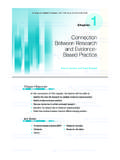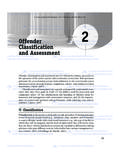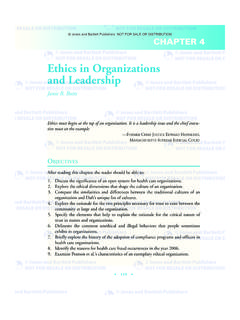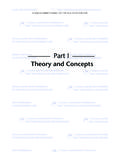Transcription of Correctional Counselors: Roles, Work Environments ...
1 8/9/07 12:16 PM Page 1. Jones and Bartlett Publishers. NOT FOR SALE OR DISTRIBUTION. Correctional Counselors: Roles, 1. work Environments , Conflicts, and Challenges The Need for Correctional Counseling This chapter gives an overview of the background information related to cor- rectional counseling. The issues examined include the current need for educated counselors in corrections, a history of Correctional counseling, basic character- istics that separate Correctional counseling from other counseling practices, cor- rectional counselors' responsibilities, as well as the types of competence and challenges for the counselors. Familiarity with the knowledge prepares readers for contents in subsequent chapters.
2 The criminal justice system consists of a complex and fragmented mixture of many agencies and programs in federal, state, and local jurisdictions that form three interconnected systems: law enforcement, law adjudication, and correc- tions. Although jails and prisons are the most visible parts of the Correctional system, pretrial and posttrial, community-based Correctional programs and work release and halfway release programs are inseparable parts of the structure. The goal of the system is both to punish and to rehabilitate (Muraskin, 2005). Statistics The Correctional population in the United States reached a new record of over 7 million at the end of 2005 (Bureau of Justice Statistics [BJS], 2006a, 2006b).
3 With only about 5% of the world's population, the United States incarcerates 1. 8/9/07 12:16 PM Page 2. Jones and Bartlett Publishers. NOT FOR SALE OR DISTRIBUTION. 2 | Correctional COUNSELORS: ROLES, work Environments , CONFLICTS, AND CHALLENGES. more than 2 million people, or a quarter of the world's 8 million prisoners (Mair & Mair, 2003). In addition, over million adult men and women were under federal, state, or local probation or parole jurisdiction at year-end 2005 (BJS, 2006a, 2006b). The increasing offender population in corrections in the United States is di- rectly correlated with the reactions of policymakers, politicians, and legislators. They believe that expediting solutions to the crime problem involves building more prisons and passing get tough sentencing laws that increased the fre- quency and length of prison terms.
4 In the late 1980s and early 1990s, 49 states passed or expanded mandatory minimum sentencing laws covering a variety of drug offenses and violent crimes. Most states enacted truth-in-sentencing laws that required violent offenders to serve a fixed portion of their prison terms. Many states passed three-strike laws that mandated long prison terms without parole for habitual offenders. These policy changes increased prison populations sharply (Parent & Barnett, 2004). The rising Correctional population is not only produced by the increase in severe punishments. Crime and criminal behavior result from the interaction of many variables, including sociological, psychological, and legal factors.
5 It is certain, however, that building more prisons has not and will not solve the crime problem. Demand and Supply The large Correctional population creates the need for educated counselors who have the knowledge, skills, values, and motivation to work with correc- tional clients. Competent counselors should be able to play an effective role in counseling multicultural clients, adhering to social justice, discerning the clients' true problems, selecting and implementing interventions, and reduc- ing recidivism. There seems to be a mismatch between the demand for Correctional coun- selors and the supply. According to the Department of Labor (Occupational Outlook Handbook, 2006 2007 edition), employment in this field (probation of- ficers and Correctional treatment specialists) is projected to grow about 9 to 17%.
6 Through 2014. In addition to the job openings as a result of growth, many jobs will be created by replacement needs, especially by the expected retirement of large numbers of Correctional staff. Probation officers and Correctional treatment specialists held about 93,000 jobs in 2004. Most jobs are in state or local gov- ernment, though some are employed by the courts and by the Depart- ment of Justice's Bureau of Prisons. In general, Correctional counselors may work in federal or state prisons, jails, community corrections ( , probation and parole), and facilities for juvenile offenders. 8/9/07 12:16 PM Page 3. Jones and Bartlett Publishers. NOT FOR SALE OR DISTRIBUTION.
7 A History of Correctional Counseling | 3. Education Qualifications The education qualifications for probation officers, Correctional treatment spe- cialists, and Correctional social workers or counselors vary by state, but most employers require a bachelor's degree (and preferably a master's degree) in so- cial work , criminal justice, psychology, or a related field, or a bachelor's degree with extensive coursework in counseling. Additional requirements by most cor- rectional agencies are that all Correctional counselors show a demonstrated in- terest in working in corrections and a belief that helping to rehabilitate or habilitate offenders is a worthy calling. Opportunities A career in Correctional counseling provides individuals with a great opportunity to use their knowledge, skills, and values to positively affect individuals as well as their communities and society.
8 The following points elaborate on the opportunities: 1. Counselors can help Correctional clients to reach their optimal growth, development, and well-being and to live a crime-free life. They work with individuals in need who are themselves the victims of crime, sex- ual abuse, family violence, discrimination, and other social problems. 2. Counselors are often required to work both in and outside the Correctional system, interacting and cooperating with family members, social service agencies, groups, community, victims, and other staff in the justice system to enhance the safety and well-being of the community and general public. 3. Counselors are given many opportunities to develop and apply coun- seling theories and practice.
9 Correctional counseling thus influences the functioning of society and the smooth operation of the criminal justice system. Through the process of assess- ment, guidance, and effective intervention and treatment of offenders, Correctional counselors help clients to function well in prison or community settings and to bal- ance their mental state and interpersonal relationships. Any individual improve- ment in social-cognitive capacity, thinking, motivation, emotions, and behavior, regardless of how insignificant it is, will benefit family, community, and society. A History of Correctional Counseling According to Schrink and Hamm (1989) and to Gendreau, Goggin, French, and Smith (2006), the history of Correctional counseling in the United States may be divided into three stages: (1) from the 1870s to 1945, (2) from 1945 to the mid- 1970s, and (3) from the mid-1970s to the present.
10 8/9/07 12:16 PM Page 4. Jones and Bartlett Publishers. NOT FOR SALE OR DISTRIBUTION. 4 | Correctional COUNSELORS: ROLES, work Environments , CONFLICTS, AND CHALLENGES. Stage 1: 1870s to 1945. Well before the turn of the 20th century, Correctional counseling in the United States was initiated and sustained by reform-minded people from probation and parole officers, clergymen, teachers to a wide variety of other persons work - ing in the corrections system. In addition, advancement in the treatment of of- fenders had been initiated by concerned citizens from outside the criminal justice system. They had volunteered their time, energy, and personal resources and con- tributed to this nation's tradition of popular justice.


















